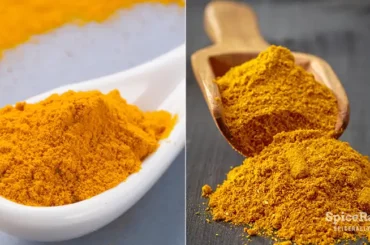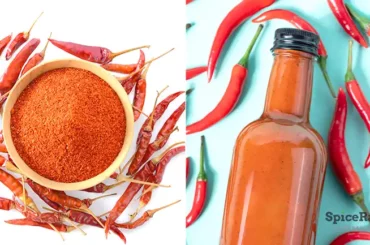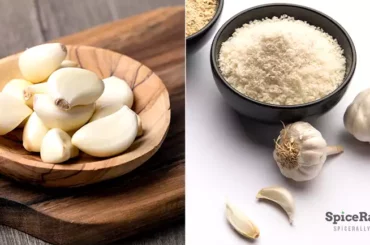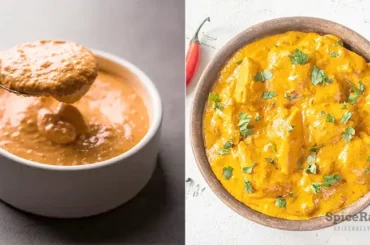Inquisitive food explorers should already know about Sri lankan curry powder and Ras el Hanout. But how do they differ? So, in this post, let’s discuss all you should know about Sri Lankan curry powder vs Ras el Hanout.
Most apparently, Sri Lankan curry powder and Ras el Hanout come from two different cultural backgrounds and they also largely deviate in content across their variations. Both have very different flavor profiles, while some Sri Lankan curry powder variations are more robust and spicier than Ras el Hanout. At the same time, traditional Ras el Hanout includes several exotic spices not typically used in ordinary spice blends.
Read along and clear all your doubts about these two spice blends while learning about them in detail!

Sri Lankan Curry Powder vs. Ras el Hanout- SpiceRally DrillDown!
| Sri Lankan Curry Powder | Ras el Hanout | |
|---|---|---|
| Flavor profile | – Depending on the ingredients used, some roasted Sri Lankan curry powder variants can be more piquant and intense than Ras el Hanout. Some variations hold a serious punch of heat, with warmer, more savory, and earthier flavor elements. – Sri Lankan unroasted curry powder is less spicy and milder than Ras el Hanout. | – Generally has a more complex, vivid flavor profile than Sri Lankan curry powder with exotic flavor notes. Very balanced in flavor and depth with spicy, warm, earthy, and richer taste elements. – Ras el Hanout is more profound, heavier, and intenser in flavor than unroasted curry powder with a subtle spiciness. |
| Base flavor | Warm and spicy | Warm and spicy |
| Ingredients | Coriander Fennel Cumin Ceylon cinnamon Black pepper Curry leaves Fenugreek seeds Black mustard seeds Cloves Green cardamom Coconut Mysore dal Chana dal Pandan leaves Uncooked rice Sesame seeds Some types might also include the following: Lemongrass Nutmeg Mace Dried red chiles Garlic Ginger | Coriander Cumin Cloves Black pepper Allspice Cinnamon Ground ginger Turmeric Cayenne pepper Paprika Dried rose buds Dried lavender Some variations might also contain the following: Cardamom Nutmeg Mace Saffron Galangal Bay leaves Cubeb pepper Aleppo chilies Celery seeds Caraway seeds Anise seeds Star anise Dried hibiscus flowers Nigella Grains of paradise Juniper berries White pepper Licorice Lovage root Long pepper Orris root Fenugreek Mustard Monk’s pepper Rapeseed oil Sugar Carrot powder Garlic powder Onion powder Yeast extract powder Maltodextrin Vegetable bullion Other preservatives and color additives |
| Texture | A dry, fine powder | A dry, fine powder |
| Heat and spiciness | Heat and spiciness typically vary, depending on the ingredients used. Variations like chicken curry powder might contain more heat than Ras el Hanout. | The spiciness largely depends on the ingredients used. But this spice blend is moderate in terms of heat. |
| Color | – Roasted curry powder is deep, rich brown, while unroasted curry powder is pale brown. – Chicken curry powder has a brownish-black tone, and Jaffna curry powder also holds a deep brown color. – The color of roasted curry powder variants depends on the roasted depth of coconut and added grains. | It usually has a yellowish-brown color. |
| Mode of usage in cooking | As an ingredient in cooking and as a finishing spice. | As an ingredient in cooking. |
| Usage in cooking | – It is mainly used to flavor up curries – It Goes well with coconut milk-based soups, stews, and broths – Spices up Asian-style rice dishes – Adds depth to meat, seafood, egg, and fish dishes – It can be included in gravies and curry sauces | – Traditionally used as a seasoning for tagines and stews. – It can be tossed with roasted vegetables – Spices up dips, sauces, and salad dressings – Ramps up certain baked goods, and desserts – It can be incorporated into rice and couscous dishes |
| Origin | Sri Lankan cuisine | Mediterranean cuisine |
| Mode of production | Both commercially made and homemade variations exist. | Both commercially made and homemade variations exist. |
| Availability | – Widely available in any grocery shop across Sri Lanka. – It can be found under a few brand names in the international spice aisle of the supermarket, Asian grocery stores, and online vendors in Western countries. | It can be purchased from supermarkets and online shopping sites under several brand names. |
| Storage | – It should be stored in glass air-tight containers in a cool, dark, dry place. – It can be kept with the rest of the spices in your spice rack. Refrigeration is not required. | – It should be stored in glass air-tight containers in a cool, dark, dry place. – It can be kept with the rest of the spices in your spice rack. Refrigeration is not required. |
| Culinary ingredient category | Spice blend | Spice blend/ seasoning |
Elaborating On The Difference Between Sri Lankan Curry Powder and Ras el Hanout
Even Though they both are known spice blends and contain some similar ingredients, Ras el Hanout is very different in its overall flavor profile than Sri Lankan curry powder and vice versa. However, both have unique ways of adding flavor and spicing up dishes.
Above all, Ras el Hanout is the traditional spice blend used in Mediterranean cuisine, while Sri Lankan curry powder is considered the heart of Sri lankan cooking. Both spice blends include ingredients that are distinctive to each of them. For example, Sri Lankan curry powder typically contains curry leaves, and pandan leaves you don’t usually see in Ras el Hanout.
On the contrary, Ras el Hanout contains exotic ingredients such as dried rose petals, orris root, sumac, saffron, etc., which we never savor in Sri Lankan curry powder. Moreover, variations like Sri Lankan unroasted curry powder can be way gentle and less spicy than Ras el Hanout.
At the same time, Sri lankan curry powder types like Jaffna and chicken curry powder can be spicier, piquant, and hotter than Ras el Hanout. Nevertheless, both spice blends do not have standard recipes. But Sri Lankan curry powder is mainly based on the flavor combination of three main spices used in each recipe, regardless of the variation.
Thus, you’ll find more coriander, cumin, and fennel in Sri Lankan curry powder, while the flavors and ingredients are much more balanced in Ras el Hanout compared to Sri Lankan curry powder.
Can Sri Lankan Curry powder And Ras el Hanout Be Used Interchangeably?
There’s a possibility to use Ras el Hanout in place of Sri Lankan curry powder and vice versa during a few exceptional instances. As we mentioned earlier, the flavor profiles of these two spice blends can be very different.
But still, due to some similar ingredients, both can be used in pinches as secondary elements in some dishes. Ras el Hanout can be substituted instead of Sri Lankan curry powder as a seasoning ingredient for meat, fish, or seafood.
Moreover, you can use Ras el Hanout in some Asian-style rice dishes to give that particular recipe an exotic kick of flavor. Likewise, you can use a roasted version of Sri Lankan curry powder to be swapped with Ras el Hanout in dishes with fish, lamb, chicken, or steak.
However, it is essential to remember that using Ras el Hanout as a substitute for Sri Lankan curry powder or vice versa is not the ideal option.




